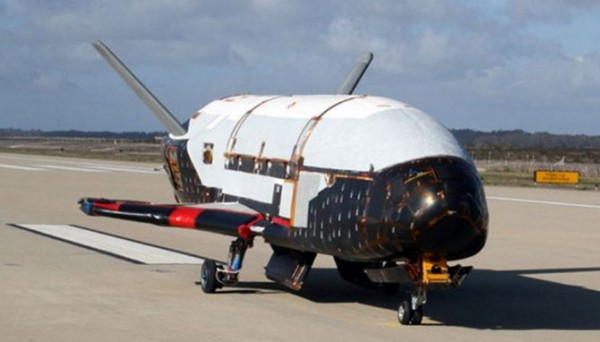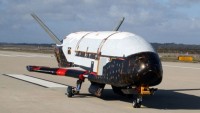US said to be Testing EmDrive Engine on Secret X-37B Spaceplane Orbiting the Earth
| Arthur Dominic Villasanta | | Nov 08, 2016 05:56 AM EST |
(Photo : USAF) X-37B of the USAF.
There are reports the U.S. Air Force might also be testing a working version of the controversial EmDrive electromagnetic thruster aboard its secret Boeing X-37B military spaceplane that's been orbiting the Earth for over 500 days.
Like Us on Facebook
If proven true, the report of an EmDrive aboard the X-37B might help explain why the spaceplane remains in orbit well past its announced mission life of 200 days.
Also called a radio frequency (RF) resonant cavity thruster, an EmDrive or Em Drive uses no reaction mass and emits no directional radiation to generate thrust. British aerospace engineer Roger Shawyer designed the EmDrive in 2001 and has promoted the idea through his company, Satellite Propulsion Research.
An EmDrive requires no chemical propellant to generate thrust, and remains controversial because it defies the accepted laws of physics, especially the law of conservation of momentum. This law states the momentum of a system is constant if there are no external forces acting on the system.
Basically this means an object won't move unless an outside force is applied to it. Because it provides thrust without consuming a propellant such as bulky rocket fuel or dangerous nuclear fuels, the EmDrive is being billed as the ideal power plant for spacecraft venturing out to other planets in our solar system and beyond.
While the Air Force hasn't confirmed speculation an EmDrive is being tested aboard the spaceplane, what is certain is the X-37B is testing a prototype "Hall Effect Thruster" (HET) in support of the Air Force's Advanced Extremely High Frequency (AEHF) communications satellite program.
The in-orbit tests include collection of telemetry from the Hall Thruster operating in the space environment, as well as measurement of the thrust imparted on the vehicle.
The U.S. Department of Defense said operational Hall Effect Thrusters or Hall Thrusters will propel military satellites (milsats) in Earth orbit or power future spacecraft on interplanetary voyages.
As a propulsion system for future U.S. space weapons, HETs will also allow the U.S. to maintain persistent orbital capabilities and lead to the development of killer satlets (small satellites); parasite satellites that attach themselves to enemy satellites to destroy them and other foreign satellite manipulation technologies.
HETs will give these milsats more maneuvering capability while granting more control over their operations.
A Hall Thruster is a type of ion thruster in which the propellant is accelerated by an electric field. It can operate on a variety of propellants, the most common being xenon. Other propellants of interest include krypton, argon, bismuth, iodine, magnesium and zinc.
Hall Thrusters are able to accelerate their exhaust to speeds between 10 km/s (36,000 km/h) to 80 km/s (288,000 km/h) with most models operating between 15 km/s (54,000 km/h) to 30 km/s (108,000 km/h).
TagsU.S. Air Force, Boeing X-37B, military spaceplane, EmDrive, Roger Shawyer, Hall Effect Thruster
©2015 Chinatopix All rights reserved. Do not reproduce without permission
EDITOR'S PICKS
-

Did the Trump administration just announce plans for a trade war with ‘hostile’ China and Russia?
-

US Senate passes Taiwan travel bill slammed by China
-

As Yan Sihong’s family grieves, here are other Chinese students who went missing abroad. Some have never been found
-

Beijing blasts Western critics who ‘smear China’ with the term sharp power
-

China Envoy Seeks to Defuse Tensions With U.S. as a Trade War Brews
-

Singapore's Deputy PM Provides Bitcoin Vote of Confidence Amid China's Blanket Bans
-

China warns investors over risks in overseas virtual currency trading
-

Chinese government most trustworthy: survey
-

Kashima Antlers On Course For Back-To-Back Titles
MOST POPULAR
LATEST NEWS
Zhou Yongkang: China's Former Security Chief Sentenced to Life in Prison

China's former Chief of the Ministry of Public Security, Zhou Yongkang, has been given a life sentence after he was found guilty of abusing his office, bribery and deliberately ... Full Article
TRENDING STORY

China Pork Prices Expected to Stabilize As The Supplies Recover

Elephone P9000 Smartphone is now on Sale on Amazon India

There's a Big Chance Cliffhangers Won't Still Be Resolved When Grey's Anatomy Season 13 Returns

Supreme Court Ruled on Samsung vs Apple Dispute for Patent Infringement

Microsoft Surface Pro 5 Rumors and Release Date: What is the Latest?











